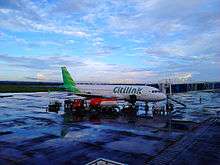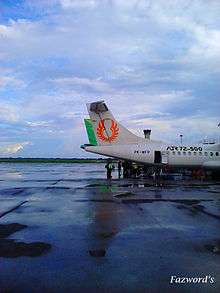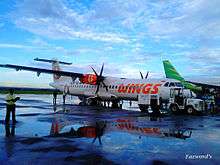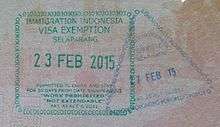Lombok International Airport
| Lombok International Airport Bandar Udara Internasional Lombok | |||||||||||||
|---|---|---|---|---|---|---|---|---|---|---|---|---|---|
|
| |||||||||||||
 | |||||||||||||
| IATA: LOP – ICAO: WADL | |||||||||||||
| Summary | |||||||||||||
| Airport type | Public | ||||||||||||
| Owner | Government of Indonesia | ||||||||||||
| Operator | PT Angkasa Pura I | ||||||||||||
| Serves | Mataram | ||||||||||||
| Location | Central Lombok, West Nusa Tenggara, Indonesia | ||||||||||||
| Built | 2006–2011 | ||||||||||||
| Elevation AMSL | 319 ft / 97 m | ||||||||||||
| Coordinates | 08°45′29″S 116°16′35″E / 8.75806°S 116.27639°ECoordinates: 08°45′29″S 116°16′35″E / 8.75806°S 116.27639°E | ||||||||||||
| Website | www.lombok-airport.co.id | ||||||||||||
| Map | |||||||||||||
 LOP Location in Lombok Island | |||||||||||||
| Runways | |||||||||||||
| |||||||||||||
| Statistics (2011) | |||||||||||||
| |||||||||||||
Lombok International Airport (Indonesian: Bandar Udara Internasional Lombok) (IATA: LOP, ICAO: WADL) is a new airport on the island of Lombok in Indonesia. It is the island's only fully operational airport.[4]
The completion of the airport project and necessary complementary infrastructure such as a highway connecting to the city of Mataram delayed inauguration of the new airport several times. At the close of 2010 the facility had still not been issued the required operational certifications and tensions persisted with local landowners. In early January 2011 the project was thought to be suffering from an estimated US$12 million deficit in the funding required for project completion.[5] In August 2011 the operational and technical director of state-owned airport management company PT Angkasa Pura-I, Haryoso Catur Prayitno suggested that the airport will be fully operational on 1 October 2011 after airport simulations which were planned to be conducted on 5–8 September 2011. Such announcements were made several times in the years immediately preceding the airport opening, only for the proposed date to pass with work still incomplete and the facility unable to open. The airport can accommodate widebody high capacity Airbus A330 and Boeing 767 airliners, as well as smaller aircraft such as Boeing 737 and Airbus A320 aircraft already serving Lombok.[6]
The new airport replaced Selaparang Airport (IATA: AMI, ICAO: WADA),[2] the island's previous sole operational airport, situated at Ampenan on the West coast of Lombok near the capital of Mataram. The first arriving aircraft was a Garuda Indonesia Boeing 737-800NG marking the commencement of operations on 1 October 2011.[7] The airport was officially inaugurated by the President of the Republic of Indonesia, Susilo Bambang Yudhoyono on 20 October 2011.
History
During the 'Indonesia Infrastructure Summit' in early 2005 airport infrastructure improvement projects including the new Lombok International Airport were presented to an international audience:
- Project milestones for the US$138.9 million Lombok project (Phase 1) are: Review of the 1993 Master Plan in 2005; detailed design 2005–2006; investment bidding 2005–2007; construction bidding 2007; implementation 2008–2011; operation from 2011 onwards.[8]
- The expansion of Lombok's existing Selaparang Airport, located near Mataram, the capital city of West Nusa Tenggara province, is restricted by the close proximity of hills. The current state of urban development is major constraint to an expansion. Therefore, the development of the new Lombok Airport will enhance the development of Mataram city.[9]
The Indonesian government is actively promoting both Lombok and neighboring Sumbawa as Indonesia's number two tourism destination after Bali. The President of Indonesia, Susilo Bambang Yudhoyono, the Ministry of Cultural and Tourism and the regional Governor have made public statements supporting the development of Lombok as a tourism destination and setting a goal of 1 million visitors annually by the year 2012 for the combined destination of Lombok and Sumbawa. [10][11] This has seen infrastructure improvements to the island including road upgrades and the construction of a much delayed new International airport in the islands south.[12] The new Lombok International Airport is a cornerstone of this tourism destination development initiated by the Government of Indonesia and regional NTB stakeholders.
The construction of this airport was delayed and the opening date re-scheduled several times. Many issues were understood to be contributing to the delays including problems with site security, thefts of construction materials and equipment from the site, issues of land disputation and tensions with some of the local community over compensation and employment on the site. Other issues involved the quality of construction of the main runway and taxiways and problems with the control tower. Delays also occurred in ratifying access for surface transport corridors including right of ways for the main connecting road to the city of Mataram. The surface connections were still under construction in late 2010 and some of the rights or way for the connecting highway to Mataram were still in disputation with the current landowners at the time of opening the airport.[13][14][15][16] In September 2010 the NTB Governor, TGH M Zainul Majdi expressed his concerns over the ongoing delays in achieving a 2010 opening and services launch in a letter to the Vice President of Indonesia, the Ministry of BUMN, Ministry of Transportation as to Angkasa Pura I the airport operator.
The secretary of commission III NTB Council, Suharto reported in 2010 that the delays to completion of the Lombok International Airport were due to a lack of funding to the order of Rp 76 Billion. Delays in project completion are consequently delaying commissioning testing by Angkasa Pura Company, certification from the Directorate General of Civil Aviation Republic of Indonesia as well as international certification requirements.[17] Aside from the funding shortfalls the issues stated to be constraining completion were the completion of an airport service road, aviation signage, terminal interiors, a terminal expansion from 12,000 to 21,000 sq m, power supplies, drainage and sewage works and the completion of the construction of access roads to and from the airport. Angkasa Pura I were reported to have approved an additional budget of Rp116 billion required for the completion of Lombok international airport in 2011 on 31 December 2010.[18][19]
The project worth Rp.945.8 billion ($111.2 million) is mainly funded by PT Angkasa Pura I.[20]
Naming of airport
Bandara Internasional Lombok (BIL) had several operational names proposed. In January 2009 results of a public opinion poll conducted in Lombok indicated that Lombok International Airport (LIA) was chosen by 40.4% of respondents, Sasak International Airport (SIA) 20%, Rinjani International Airport (RIA) 46 16.7%, Mandalika the International Airport (MIA) 10.9%, Selaparang International Airport ( SIA) 8%, Pejanggik International Airport (PIA) 2.9%, and Arya Banjar Brittle International Airport (ABGIA) 1.1%.[21]
The IATA code LOP only came into formal use in late November 2011. Prior to that the IATA code AMI, from Selaparang, was used by the airlines servicing the airport. Garuda and Batavia began to partially adopt the LOP code in their booking and ticketing systems at that time. Lion Air was still using AMI at the end of November 2011, however all flights were operating solely to and from Lombok International Airport.
Location
The airport site is at Tanak Awu, in Kabupaten Lombok Tengah (Regency of Central Lombok), Lombok, Indonesia, south west of Mataram the provincial capital of Nusa Tenggara Barat and a few kilometers south west of the small regional city of Praya. The airport deploys in 551.8 hectares with cost Rp.945.8 billion ($108 million) which PT Angkasa Pura-I shouldering Rp.795.8 billion, West Nusa Tenggara province Rp.110 billion and Central Lombok Regency Rp.40 billion.[22][23] The Lombok International Airport area has the second largest area after Soekarno–Hatta International Airport.[24]
Destinations
When the Lombok International Airport became operational all the existing flight schedules at Lombok's Selaparang Airport were moved across to the new airport.
As Selaparang Airport never accommodated wide bodied aircraft it is expected that further international and domestic services will soon supplement the existing routes providing higher passenger loads and freight volumes to those of the existing airport at Ampenan.




Airlines and destinations
| Airlines | Destinations |
|---|---|
| AirAsia | Kuala Lumpur–International |
| Batik Air | Jakarta–Halim Perdanakusuma, Jakarta–Soekarno–Hatta |
| Citilink | Jakarta–Halim Perdanakusuma, Jakarta–Soekarno–Hatta, Surabaya |
| Garuda Indonesia | Bima, Denpasar/Bali, Jakarta–Soekarno–Hatta, Makassar, Semarang, Sumbawa Besar, Surabaya Hajj: Jeddah |
| Lion Air | Denpasar/Bali, Jakarta–Soekarno–Hatta, Kupang(Begins 8 December 2016), Makassar, Solo, Surabaya, Yogyakarta |
| SilkAir | Singapore |
| Wings Air | Bima, Denpasar/Bali, Sumbawa Besar |
Public facilities and access
The airport is served by road links to the city of Mataram which is approximately 40 km to the northwest of the airport. The airport is approximately 55 km southeast of the established Senggigi tourism precinct of West Lombok. An integral component of the airport project was the building of a new link road to the city of Mataram to provide ready access to both city and the established tourism facilities on the west coast of the island. At the time of opening in late 2011 some sections of the new road remained incomplete. The developing area of Kuta and Selong Blanik lie 30 minutes to the south of the airport and provide some reasonably developed tourist facilities including hotels and restaurants.
The airport is not served by rail connections and there are none available on the island. The airport location is some distance from existing townships and external services, the nearest regional city is Praya, to the immediate north of the airport.
Tour desk, booking kiosks and other facilities are also available at the main terminal.
Car and bus parking
The airport has extensive paved parking areas available at the main terminal and smaller facilities for the cargo terminal and administrative areas. Entrance is by a single controlled access point to the nearby highway.
Public bus services
DAMRI provide a public airport shuttle service to Terminal Mandalika (city bus terminal) on the eastern outskirts of Mataram and on to the west coast at Senggigi. The public bus service uses a dedicated fleet of modern air-conditioned buses and provides a scheduled service for set fees.
Taxi services
When the airport services were moved across from the previous facilities at Selaparang the Airport Taksi Koperasi moved operations to BIL. Upon the commencement of services from BIL they ceased to provide a set distance pre-paid docket system and adopted a metered (argometer) method of charging for distance travelled. The Airport taxi service is supplemented by metered taxis provided by the two established operators Bluebird Taxi and Express Taxi.
Charter
Helicopter and fixed wing charter services are available by prior arrangement.
Construction program
The runway, taxiways and apron were in final stages of construction and facilities installation in the 3rd quarter of 2010. Terminal and other support facilities were in final stages of completion toward the end of September 2011. The final opening date of the airport was scheduled and then subsequently postponed many times. The announced date for a formal opening on 1 October was in part responding to a pressing need to commence operations before the commencement of the annual Hadj flights in late 2011.
Phase I (2006–2009)
- Runway: 45 m x 2500 m
- Apron: 52,074 m²
- Taxiway: 2 exit taxiways
- Terminal: 12,000 m² (passenger, VIP, cargo)
- Carpark: 17,500 m²
Phase II (2013–2015)
- Runway: 45m x 2750m
- Apron: 63,294 m²
- Taxiway: 2 exit taxiways
- Terminal: 16,500 m² (2.4M passengers per year)
- Carpark: 29,100 m²
Phase-III (2028)
- Runway: 45 m x 4,000 m
- Apron: 74,514 m²
- Taxiway: 12 exit taxiways, 2 rapid exit taxiways, 1 parallel taxiway
- Terminal: 28,750 m² (3.25M passengers per year)
- Carpark: 29,100 m²[25]
Project Summary, Jakarta, 4 January 2005
Airport Statistics
| Airfield System[8] | Phase 2 | Phase 3 |
|---|---|---|
| Runway Length | 2,750 m | 4,000 m |
| Runway Width | 45 m | 45 m |
| Runway Shoulders | 30 m | 30 m |
| Runway Strips | 2,870 m x 300 m | 4,120 m x 300 m |
| Runway End Safety Area | 90 m x 90 m | 90 m x 90 m |
| Taxiway Requirements | Two Apron Exits | Full Parallel |
| Taxiway Width | 23 m | 23 m |
| Taxiway Shoulder | 7.5 m | 10.5 m |
| RW-TW separation | 192 m | 192 m |
| Apron Service Road Width | 10 m | 10 m |
| Support Area Service Road Width | 7 m | 7 m |
| Airfield Inspection Road Width | 5 m | 5 m |
| Security Fence Height | 2 m | 2 m |
| Aircraft Parking Areas | Phase 2 | Phase 3 |
| Aircraft Parking Requirement | 10 | 30 |
| Aircraft Apron Area | 53,200 m | 300,000 sm |
| Air Cargo Apron | 28,000 sm | |
| General Aviation Apron | 25,000 sm | |
| Navigational Aids | Phase 2 | Phase 3 |
| Air Traffic Control Tower | 23 m high | 23 m high |
| Precision Landing System | R/W 13 ILS | R/W 13 ILS |
| Runway Lighting | High Intensity | High Intensity |
| Other NAVAIDs | DME, DVOR NDB | DME, DVOR NDB |
Fire fighting and emergency services
- Category VIII – trained personnel, 30
- Foam tender – Type I
- Foam tender – Type II
- Crash Car Type 1 – 3 units
- Rescue Tender – I unit
- Rescue Boat – 2 units
- Nurse Tender – 1 unit
- Ambulance – 1 unit
- Utility Car – 2 unit
- Tanker – 2 units
- Commando Car – 1 unit
The airport has no capability for the removal of disabled aircraft.[1]
Airport facilities and services
- Cargo handling facilities are provided by PT Gapura, PT. Jas, PT PTN, PT Kokapura
- Fuelling facilities – Avtur 50 / Jet A1 – 2 dispenser cap 550 KL, 3 tank refueller@12 KL 1 tank refueller @ 15 KL
- De-Icing Facilities – none
- Hangar space for visiting aircraft – none
- Repair facilities for visiting aircraft – none
- AD Administration – Mon–Thu: 00.00 – 08.30, Fri: 23.00–07.30
- Custom and Immigration – Mon–Sun: 2300–1300
- Health and Sanitation – Mon–Sun: 2300–1300
- AIS Briefing Office – Mon–Sun: 2300–1300
- ATS Reporting Office – Mon–Sun: 2300–1300
- MET Briefing Office – Mon–Sun: 2300–1300
- ATS – Mon–Sun: 2300–1300
- Security – 24hrs
Information on flight procedures, communication procedures and airfield beacon and navigational aids were published by the Directorate General of Civil Aviation (Indonesia) in an AIRAC document published on 28 July 2011 with an effective date of 22 September 2011.[1]
Aircraft types
B747, B767, A340, A330, B777, C130, A320, B737-900, CRJ1000, F100, F28, F50, MA60, ATR72, CN235,[1] XL2.
Aircraft parking stands
- Stands Nr. 5 and 7 – available for B747, A330, B777, or below. Avio–Bridge available, with a RLG visual docking guidance system installed
- Stands Nr. 1, 2, 3, 4, 6, 8, 9 and 10 – available for B737-900 or below
- Security line apron taxiway – 76.00 m (distance)[1]
Flight Schools
The airport is a temporary base, from 1 October-1 December 2011, for a local flight training academy "LIFT" (Lombok Institute of Flight Technology) operating 3 Liberty XL2 training aircraft 6 days per week.
References
- 1 2 3 4 5 http://hubud.dephub.go.id/files/dokumen/AIP%20SUPP%2004%20Tahun%202011.pdf
- 1 2 "It's for Real: Lombok Finally Has Its International Airport". The Jakarta Globe. Retrieved 4 June 2015.
- ↑ Universal Avionics Systems Corporations. "Universal Avionics - Error Page" (PDF). uasc.com.
- ↑ IATA. "IATA - Codes - Airline and Airport Codes Search". Retrieved 4 June 2015.
- ↑ Fitri (30 December 2010). "Problems May Delay Lombok Airport Opening Again". Jakarta Globe.
- ↑ "Lombok International Airport to operate soon". Retrieved 4 June 2015.
- ↑ "Island in focus: New airport begins service". 3 October 2011.
- 1 2 New Lombok International Airport, The Directorate General of Air Communication, and PT. (Persero) Angkasa Pura 1, Project Summary, Jakarta, 4 January 2005
- ↑ "Airport Development News" (PDF). Momberger Airport Information. December 2005. Retrieved 29 August 2010. External link in
|publisher=(help) - ↑ "President gives full support to tourism". The Jakarta Post, Senggigi, West. Nusa Tenggara, Panca Nugraha, The Archipelago. 7 July 2009. Retrieved 8 July 2009.
- ↑ "Lombok, Sumbawa eying 1 million tourists by 2012". The Jakarta Post, Jakarta. 5 April 2010. Retrieved 10 July 2010.
- ↑ "An invitation from Lombok". The Jakarta Post, Jakarta, by Trisha Sertori, Lombok, Mon, 7 June 2009 11:30 AM. Retrieved 7 July 2009.
- ↑ Luc Citrinot (ETN Senior Managing Editor Asia) (19 November 2009). "Lombok eyes 2012". eturbonews.com.
- ↑ "Bali News: Delays in Opening of Lombok's New Airport". Bali Discovery Tours. Retrieved 29 August 2010.
- ↑ "NTB governor to brief central govt on bil project". ANTARA News. 14 June 2010. Retrieved 29 August 2010.
- ↑ http://bali-news-views.blogspot.com/2010/06/vp-orders-new-bali-and-lombok-airports.html | VP Orders new Bali and Lombok Airports to be Operational soon, Indonesian Digest, Weds, 30 June 2010 |Downloaded 28 Aug 2010
- ↑ http://www.lombokpost.co.id Lombok Post Sept 2010, In Indonesian Language
- ↑ "Bandara Internasional Lombok Beroperasi Akhir Juli". Media Indonesia. 28 December 2010. Retrieved 4 December 2011.
- ↑ Oleh Sutarno (3 January 2010). "AP1(Angkasa Pura1) Didesak tuntaskan bandara Lombok". Bisnis Indonesia. Retrieved 4 December 2011.
- ↑ "NTB eager to have Lombok airport up and running". Retrieved 4 June 2015.
- ↑ http://www.sasak.org/berita/pariwisata/1669-lalu-wiratmaja-inginkan-gajah-mada-airport-untuk-bil.html
- ↑ New airport to 'support' tourism beyond Bali | The Jakarta Post
- ↑ "President dedicates new Lombok airport". 20 October 2011.
- ↑ "Alhamdulillah, BIL Mulai Dioperasikan". 1 October 2011.
- ↑ Lombok Times Daily, issue #62, February – March 2009
External links
- PT. Angkasa Pura 1 (PERSERO)
- Bandara Internasional Lombok official website
- Kabupaten Lombok Tengah, the Regency of Central Lombok
- Directorate General of Civil Aviation Republic of Indonesia